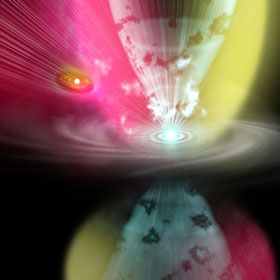Detection of Extended High Circular Polarization in the Orion Nebula
| Science

The origin of biomolecular homochirality is a longstanding mystery. This is the phenomenon that terrestrial living material consists almost exclusively of one enantiomer, left-handed amino acids. Amino acids in several meteorites (e.g., Murchison) have been found to have enantiomeric excesses of the same handedness as that seen in biological amino acids. Such detection of enantiomeric excesses in meteorites is consistent with the hypothesis that terrestrial life was seeded by the delivery of organics from outer space during the heavy bombardment phase of early Earth. Enantiomeric excesses can be produced by circularly polarized light through asymmetric photochemistry, such as asymmetric photolysis or synthesis as shown in laboratory experiments. Astronomical sources of circularly polarized light that might induce enantiomeric excesses in interstellar material have been investigated. In this research, we present a wide-field and deep near-infrared (Ks band: 2.14 μm) circular polarization image in the Orion nebula. In the Orion nebula, massive stars and many low-mass stars are forming. Our results reveal that a high circular polarization region is spatially extended around the massive star-forming region (called the BN/KL nebula). Significant circular polarization extends over a region ∼400 times the size of the solar system. However, other regions show no significant circular polarization. Most of the low-mass young stars do not show detectable extended structure in either linear or circular polarization, in contrast to the BN/KL nebula. Our results and the feature of the Orion nebula implies as follows: If our solar system formed in a massive star-forming region and was irradiated by net circularly polarized radiation, then enantiomeric excesses could have been induced, through asymmetric photochemistry, in the parent bodies of the meteorites and subsequently delivered to Earth. These could then have played a role in the development of biological homochirality on Earth.
This research is on publication in Origins of Life and Evolution of Biospheres: Fukue et al. 2010, "Extended High Circular Polarization in the Orion Massive Star Forming Region: Implications for the Origin of Homochirality in the Solar System", DOI:10.1007/s11084-010-9206-1. This is in Springer's open access.
Link
More info: SIRPOL Press Release web page